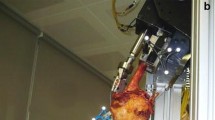Abstract
Introduction
An edema of the infrapatellar fat pad following knee arthroscopy or in case of chronic anterior knee pain syndrome is suspected to increase the patellofemoral pressure by a modification of the patellofemoral glide mechanism. The study was performed to evaluate this hypothesis.
Materials and methods
Isokinetic knee extension from 120° of flexion to full extension was simulated on 10 human knee cadaver specimens (six males, four females, average age at death 42 years) using a knee kinemator. Joint kinematics was evaluated by ultrasound sensors (CMS 100TM, Zebris, Isny, Germany), and retro-patellar contact pressure was measured using a thin-film resistive ink pressure system (K-ScanTM 4000, Tekscan, Boston). Infrapatellar tissue pressure was analyzed using a closed sensor cell which was implanted inside the fat pad (GISMA, Buggingen, Germany). An inflatable fluid cell was implanted by ultrasound control in the center of the infrapatellar fat pad and filled subsequently with water to simulate a fat pad edema. All parameters were recorded and analyzed from 0 to 5 ml volume of the fluid cell.
Results
Simulating a fat pad edema resulted in a significant (P < 0.01) increase of the infrapatellar fat pad pressure (247 mbar at 0 ml to 615 mbar at 5 ml volume). In knee extension and flexion the patella flexion (sagittal plane) was decreased while we did not find any other significant influence of the edema on knee kinematics. During the analysis of the patellofemoral biomechanics, a simulated fat pad edema resulted in a significant (P < 0.05) decrease of the patellofemoral force between 120° of knee flexion and full extension. The contact area was reduced significantly near extension (0°–30°) by an average of 10% while the contact pressure was reduced at the entire range of motion up to 20%.
Conclusion
An edema of the infrapatellar fat pad does not cause an increase of the patellofemoral pressure or a significant alteration of the patellofemoral glide mechanism. Anterior knee pain in case of a fat pad edema may be related to a significant increase of the tissue pressure and possible histochemical reactions.








Similar content being viewed by others
References
Abe T, Morgan DA, Guttermann DD (1997) Protective role of nerve growth factor against postischemic dysfunction of sympathetic coronary innervation. Circulation 95:213–220
Apostolaki E, Cassar-Pullicino VN, Tyrrell PNM, McCall IW (1999) MRI appearances of the infrapatellar fat pad in occult traumatic patellar dislocation. Clin Radiol 54:743–747
Bentley G (1989) Anterior knee pain: diagnosis and management. J R Coll Surg Edinb 34:2–3
Bohnsack M, Wilharm A, Hurschler C, Rühmann O, Stukenborg-Colsman C, Wirth CJ (2004) Biomechanical and kinematic influences of a total infrapatellar fat pad resection on the knee. Am J Sports Med 32:1873–1880
Bohnsack M, Hurschler C, Demirtas T, Rühmann O, Stukenborg-Colsman C, Wirth CJ (2005) Infrapatellar fat pad pressure and volume changes of the anterior compartment during knee motion—possible clinical consequences to the anterior knee pain syndrome. Knee Surg Sports Traumatol 13:135–141
Bohnsack M, Meier F, Walter GF, Hurschler C, Schmolke S, Wirth CJ, Rühmann O (2005) Distribution of substance-P nerves inside the infrapatellar fat pad and the adjacent synovial tissue—a neurohistological approach to the anterior knee pain syndrome. Arch Orthop Trauma Surg (epub)
Dye SF, Vaupel GL, Dye CC (1998) Conscious neurosensory mapping of the internal structures of the human knee without intra-articular anesthesia. Am J Sports Med 26:733–777
Faletti C, De Stefano N, Giudice G, Larciprete M (1998) Knee impingement syndromes. Eur J Radiol 27:60–69
Fulkerson JP (1998) Evaluation of the peripatellar soft tissues and retinaculum in patients with patellofemoral pain. Clin Sports Med 8:197–202
Harrison S, Geppetti P (2001) Substance P. IJBCB 33:555–576
Hoffa A (1904) The influence of the adipose tissue with regard to the pathology of the knee joint. JAMA 43:795–796
Jacobson KE, Flandry FC (1989) Diagnosis of anterior knee pain. Clin Sports Med 8:179–195
Jacobson JA, Lenchik L, Ruhoy MK, Schweitzer ME, Resnick D (1997) MR imaging of the infrapatellar fat pad of Hoffa. Radiographics 17:675–691
James SL (1979) Chondromalacia of the patella in the adolescent. In: Kennedy JC (ed) The injured adolescent knee. Williams & Wilkins, Baltimore, pp 205–251
Lee TH, Kato H, Kogure K, Itoyama H (1996) Temporal profile of nerve growth factor-like immunoreactivity after transient focal cerebral ischemia in rats. Brain Res 713:199–210
Magi M, Barca A, Bucca C, Langerance V (1991) Hoffa disease. Ital J Orthop Traumatol 17:211–216
Malcangio M, Bowery NG (1999) Peptide autoreceptors: does an autoreceptor for substance-P exist? Trends Pharmacol Sci 20:405–407
Malek MM, Mangine RE (1981) Patellofemoral pain syndromes: a comprehensive and conservative approach. J Orthop Sports Phys Ther 2:108–116
Ogilvie-Harris DJ, Giddens J (1994) Hoffa’s disease: arthroscopic resection of the infrapatellar fat pad. Arthroscopy 10:184–187
Post WR, Fulkerson JP (1993) Anterior knee pain—a symptom not a diagnosis. Bull Rheum Dis 42:5–7
Sandow MJ, Goodfellow JW (1985) The natural history of anterior knee pain in adolescents. J Bone Joint Surg 67-B:36–38
Witonski D, Wagrowska-Danielewicz M (1999) Distribution of substance-P nerve fibers in the knee joint in patients with anterior knee pain syndrome. Knee Surg Sports Traumatol Arthrosc 7:177–183
Woolf CJ, Allchorne A, Safieh-Garabedian B, Poole S (1997) Cytokines, nerve growth factor and inflammatory hyperalgesia: the contribution of tumor necrosis factor alpha. Br J Pharmacol 121:417–424
Acknowledgments
We gratefully thank the German Speaking Association of Artroscopy (AGA) for the funding of this study.
Author information
Authors and Affiliations
Corresponding author
Additional information
The study was funded by the German Speaking Association of Artroscopy (AGA).
Rights and permissions
About this article
Cite this article
Bohnsack, M., Klages, P., Hurschler, C. et al. Influence of an infrapatellar fat pad edema on patellofemoral biomechanics and knee kinematics: a possible relation to the anterior knee pain syndrome. Arch Orthop Trauma Surg 129, 1025–1030 (2009). https://doi.org/10.1007/s00402-006-0237-z
Received:
Published:
Issue Date:
DOI: https://doi.org/10.1007/s00402-006-0237-z




